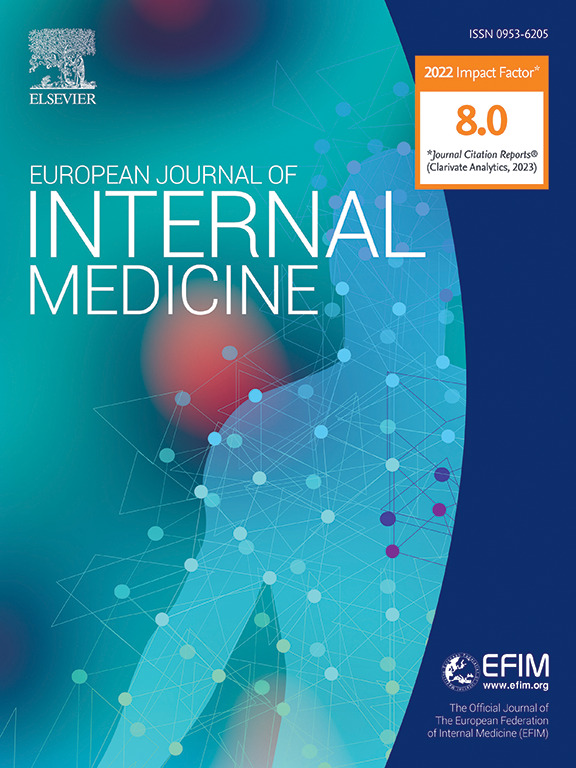致敏模式对COPD严重程度和恶化的影响:来自病例对照和纵向研究的见解
IF 5.9
2区 医学
Q1 MEDICINE, GENERAL & INTERNAL
引用次数: 0
摘要
背景:在许多研究中,总免疫球蛋白E (tIgE)和过敏原特异性IgE (sIgE)与哮喘有关,新出现的证据表明IgE致敏会影响慢性阻塞性肺疾病(COPD)的发病和严重程度。本研究探讨了(a)血清tIgE和sIgE在COPD、哮喘和对照组之间是否存在差异(病例对照亚研究),以及(b) 343例COPD患者的tIgE和300个个体sIgE水平是否与疾病严重程度和结局相关(纵向亚研究)。方法:病例对照亚研究测量了122名参与者(COPD 76人,哮喘19人,对照组27人)的tIgE和sIgE。这项纵向亚研究分析了343名COPD患者的tIgE和300 sIgE,检查了疾病严重程度和结果的联系。特应性定义为tIgE bbb20 kUA/L,皮肤致敏性以皮肤点刺试验阳性确定。结果:哮喘、慢性阻塞性肺病和对照组的sIgE无显著差异,但哮喘和慢性阻塞性肺病患者对各种过敏原表现出不同的sIgE模式。与非特应性男性相比,特应性男性因慢性阻塞性肺病(ECOPD)急性加重而紧急就诊的人数较少(79.07% vs. 91.33%, p = 0.007),而皮肤敏感的女性比非皮肤敏感的女性经历更严重的ECOPD (46.43% vs. 24.36%, p = 0.028)。加重的病因与特应性或皮肤致敏无关。真菌致敏与年龄较大(p = 0.032)、6分钟步行试验结果较差(p = 0.007)和扩散能力降低(DLCO/VA %, p = 0.006)相关。结论:虽然各组间的特应性特征相似,但哮喘具有较高的气致过敏原sIgE。皮肤致敏和特应性可能影响COPD患者的肺功能和症状严重程度,但与ECOPD的性别相关性不同,与ECOPD的病因无关。本文章由计算机程序翻译,如有差异,请以英文原文为准。
The impact of sensitization patterns on COPD severity and exacerbations: Insights from a case-control and longitudinal study
Background
Total Immunoglobulin E (tIgE) and allergen-specific IgE (sIgE) have been linked to asthma in numerous studies, with emerging evidence suggesting IgE sensitization influences chronic obstructive pulmonary disease (COPD) onset and severity. This study explores whether (a) serum tIgE and sIgE profiles differ among COPD, asthma, and controls (case-control substudy) and (b) tIgE and 300 individual sIgE levels correlate with disease severity and outcomes in 343 COPD patients (longitudinal substudy).
Methods
The case-control substudy measured tIgE and sIgE in 122 participants (76 COPD, 19 asthma, 27 controls). The longitudinal substudy analyzed tIgE and 300 sIgE in 343 COPD patients, examining links to disease severity and outcomes. Atopy was defined as tIgE>20 kUA/L, while skin-sensitization was determined by skin prick test positivity.
Results
No significant tIgE differences were observed among asthma, COPD, and controls, however asthma and COPD patients showed distinct sIgE patterns for various allergens. Atopic men reported fewer urgent visits for acute exacerbations of COPD (ECOPD) than non-atopic men (79.07 % vs.91.33 %, p = 0.007), while skin-sensitized women experienced more severe ECOPD than non-skin-sensitized women (46.43 % vs. 24.36 %, p = 0.028). Exacerbation etiology was not associated with atopic or skin-sensitization profiles. Fungal sensitization correlated with older age (p = 0.032), worse 6-minute walking test outcomes (p = 0.007), and reduced diffusion capacity (DLCO/VA %, p = 0.006).
Conclusion
While atopic profiles are similar across groups, asthma features higher aeroallergen sIgE. Skin-sensitization and atopy may influence lung function and symptom severity in COPD but are differently associated with ECOPD between sexes and are not linked to the etiology of ECOPD.
求助全文
通过发布文献求助,成功后即可免费获取论文全文。
去求助
来源期刊
CiteScore
9.60
自引率
6.20%
发文量
364
审稿时长
20 days
期刊介绍:
The European Journal of Internal Medicine serves as the official journal of the European Federation of Internal Medicine and is the primary scientific reference for European academic and non-academic internists. It is dedicated to advancing science and practice in internal medicine across Europe. The journal publishes original articles, editorials, reviews, internal medicine flashcards, and other relevant information in the field. Both translational medicine and clinical studies are emphasized. EJIM aspires to be a leading platform for excellent clinical studies, with a focus on enhancing the quality of healthcare in European hospitals.

 求助内容:
求助内容: 应助结果提醒方式:
应助结果提醒方式:


